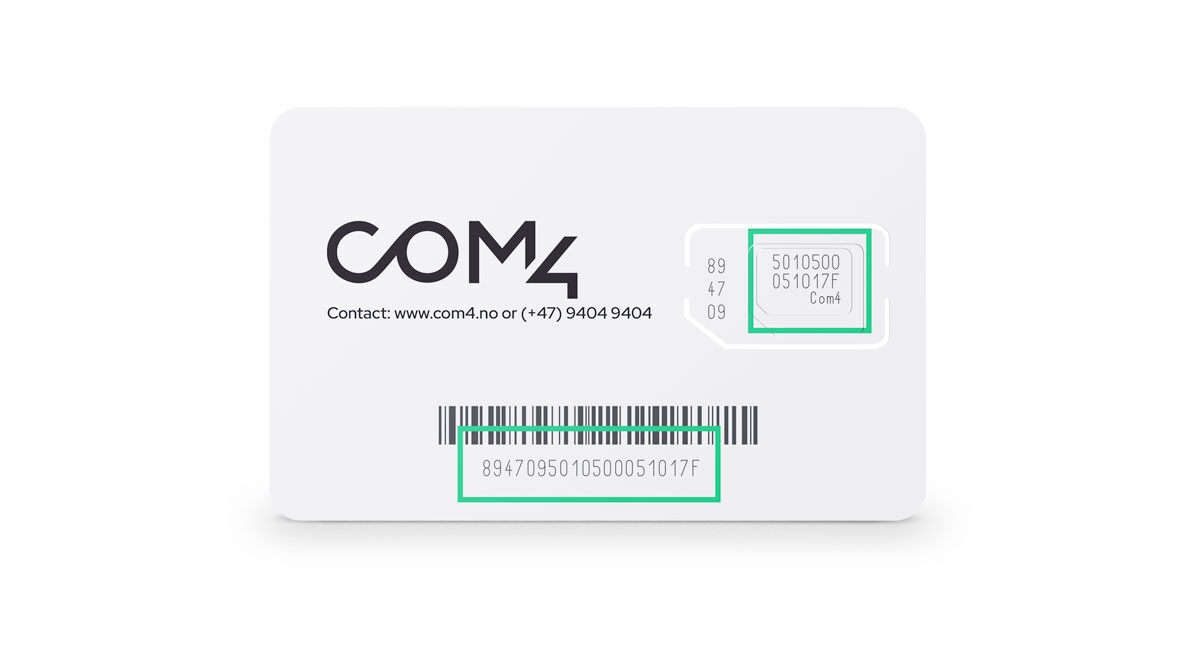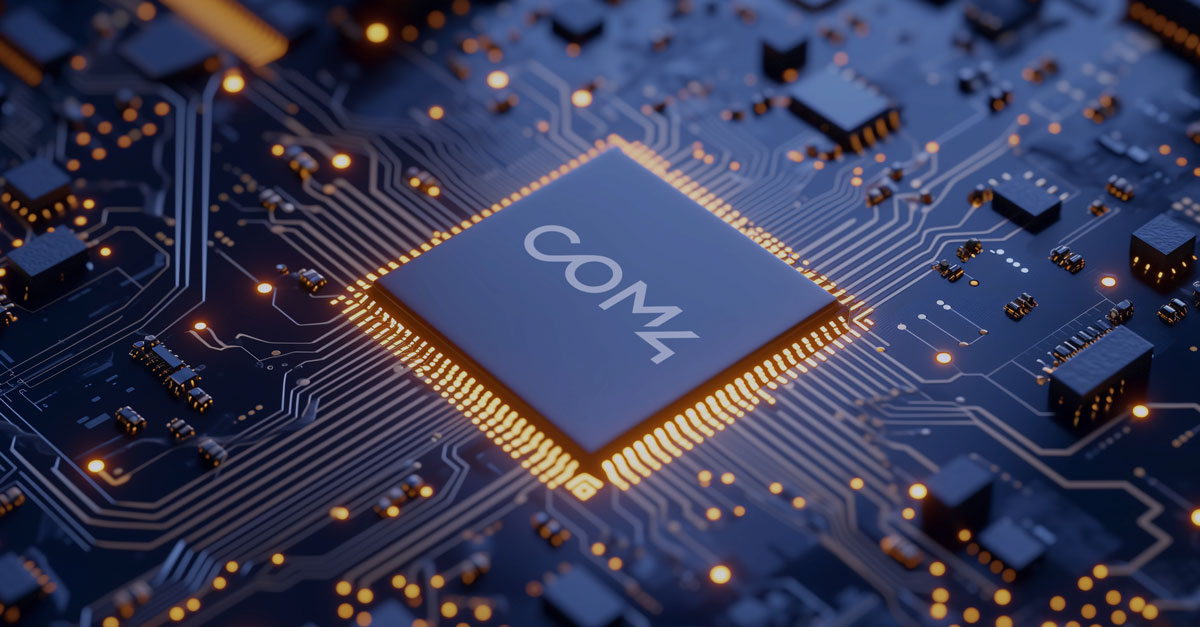This article explores the structure and importance of ICCID numbers, highlighting their relevance in modern telecommunications, especially for Com4 customers.
What is an ICCID Number?
ICCID stands for Integrated Circuit Card Identifier. It is a unique number found on every SIM card. Think of it like a fingerprint for the SIM. It helps the mobile network identify and authenticate the SIM and ensures the device gets connected to the right service. In IoT systems, many devices operate across different locations. ICCIDs help keep these connections organised and running smoothly.
You will usually find the ICCID printed on the SIM card or its packaging. On many smartphones, you can also see it in the settings under “About”. For devices in the field, especially in IoT, you can retrieve it remotely using commands or API.
Format and Structure of ICCID Number
ICCID numbers follow a defined structure that encodes key details about the SIM card and its origin. Each section of the number serves a specific purpose:
Industry Identifier: The first two digits are always 89. They identify the telecommunications industry and confirm that the card is a SIM.
Country Code: The next two or three digits represent the country where the SIM card was issued. These are assigned by the International Telecommunication Union (ITU) and follow global numbering standards.

Mobile Network Code (MNC): After the country code, one to four digits indicate the mobile network operator that issued the SIM card. This section links the SIM to a specific carrier or service provider.


Why ICCID Numbers Matter for Com4 Customers
ICCID numbers are fundamental for various reasons:
- Device Identification: Crucial for identifying the SIM card within a device, enabling seamless connectivity.
- Network Operations: Essential for network providers like Com4 to manage and provision services effectively.
- Customer Support: Needed for activating services, troubleshooting issues, and assisting customers with their accounts.
Finding Your ICCID Number
Locating the ICCID number is straightforward. It’s typically printed on the SIM card itself or on the packaging. For mobile devices, you can also find it within the device settings under the "About" or "SIM Card" section.

Importance of ICCID Numbers in IoT
When you’re managing a large group of connected devices, things can get complicated fast. ICCID numbers give you a way to track and manage each SIM card with confidence. They play a big role in:
- Matching SIMs to devices during setup
- Troubleshooting network issues
- Managing devices and SIMs remotely
In Com4’s projects, such as Sensorita’s waste management system, ICCIDs help operators identify and manage each SIM in their devices. This makes large-scale deployments easier to monitor and maintain.
ICCID vs IMSI vs IMEI: What is the Difference?
In any connected system, three key identifiers keep devices, SIM cards and networks in sync. These are the ICCID, IMSI and IMEI. Although they look similar, each serves a different purpose in how mobile and IoT devices connect, authenticate and communicate. Understanding their roles helps ensure smooth device management and accurate troubleshooting in IoT deployments.
Here is how they differ:
| Identifier | Full Form | What it Identifies | Stored On | Key Function in IoT |
|
ICCID |
Integrated Circuit Card Identifier | The SIM-card itself | SIM card | Used to identify, activate and manage SIM cards across networks and devices. |
| IMSI | International Mobile Subscriber Identity | The mobile subscriber or service user | SIM card | Used by the mobile network to authenticate and register the SIM on the network. |
| IMEI | International Mobile Equipment Identity | The physical mobile or IoT device | Device hardware | Used to identify the device on the network and prevent unauthorized or stolen device access. |
In simple terms, the ICCID tells the network what SIM card it is, the IMSI tells who is using it, and the IMEI tells which device is connected.
IMSI (International Mobile Subscriber Identity)
The IMSI is a 15-digit number used by cellular networks to identify the subscriber’s line of service. It includes:
- Mobile Country Code (MCC): The first three digits.
- Mobile Network Code (MNC): The next two or three digits.
- Subscriber Identification: The remaining digits.
IMEI (International Mobile Equipment Identity)
The IMEI is a unique 15-digit number assigned to mobile devices, identifying the device itself rather than the SIM card. It consists of:
- Reporting Body Identifier: The first two digits.
- Type Allocation Code (TAC): The next six digits.
- Device Identifier: The following six digits.
- Check Digit: The final digit, calculated using the Luhn algorithm.
How to Find Your ICCID Number?
Finding an ICCID is simple, but the method can vary depending on your device or setup. Here are the most common methods used by both regular users and IoT professionals.
Step 1. Check the SIM Card or Its Packaging
- Most SIM cards have the ICCID printed on the plastic card or its packaging.
- The number is usually placed near the barcode or gold chip.
- For eSIM or iSIM devices, the ICCID can be found in the product documentation or through the IoT management platform.
Step 2. View It on the Device Settings
- iPhones show the ICCID under Settings > General > About.
- Android devices display it under Settings > About phone > Status > SIM information.
- This method is quick and avoids removing the SIM card from the device.
Step 3. Retrieve It Using AT Commands
- For IoT devices, you can send AT+CCID to the modem or module to read the ICCID.
- This command works with modems from SIMCom, Quectel and u-blox, among others.
- It allows engineers to identify and verify SIMs remotely, which is ideal for large-scale deployments.
Step 4. Access It Through Your Connectivity Platform
- Many IoT connectivity platforms display ICCIDs in the dashboard or API data.
- The information usually includes SIM status, connection logs and network details.
- Platforms supported by Com4, for example, make it easy to track SIM health and manage active connections.
ICCID Numbers in the Era of eSIMs
As IoT technology evolves, traditional plastic SIM cards are being replaced by embedded SIMs (eSIMs) and integrated SIMs (iSIMs). Despite these changes, ICCID numbers remain an important part of how devices are identified and managed.
- Each eSIM profile still has its own ICCID number, just like a regular SIM card.
- The ICCID helps operators track and manage each downloaded profile remotely.
- Devices with eSIMs also have a permanent EID (Embedded Universal Integrated Circuit Card Identifier), which stays fixed to the hardware.
- The EID manages multiple ICCID profiles on one device, making it easier to switch between mobile networks without replacing a SIM card.
When planning IoT deployments, choosing between eSIM and iSIM technology depends on scale, cost, and flexibility. For a closer look at which option fits best, you can read our guide: eSIM or iSIM.
Real-World Use Cases and Best Practices
ICCID numbers are quietly at work behind every connected device, helping ensure each SIM is correctly identified and managed. Here are some real-world examples of how ICCIDs support IoT operations across industries.
- Smart Energy and Utilities: Power and water companies use ICCIDs to monitor thousands of smart meters deployed across cities. Each meter’s SIM is registered by its ICCID, allowing operators to track status, update firmware and detect outages remotely.
- Fleet and Asset Tracking: In transport and logistics, ICCIDs are used to register and manage vehicle trackers. When a tracker reports location data, its ICCID helps link it to the correct account and ensures accurate billing and reporting.
- Industrial Automation: Factories that use connected sensors and controllers rely on ICCIDs to manage SIMs inside production equipment. This allows maintenance teams to monitor connectivity, detect network faults and swap or reassign SIMs when needed.
- Healthcare Monitoring: Medical IoT devices such as remote patient monitors and emergency alert systems use ICCIDs to maintain a secure link between the device and the healthcare platform. This ensures reliable data flow for continuous patient monitoring.
- Smart Agriculture: In connected farming, ICCIDs help operators track devices such as soil sensors, irrigation systems and weather stations spread across large areas. The ICCID lets platforms verify which devices are active and transmitting data in real time.
These examples show that the ICCID is not just a technical identifier. It is a key part of how connected systems remain reliable, traceable and secure at scale.
The Role of ICCID in Embedded SIM Technology
Embedded SIM (eSIM) technology is revolutionizing mobile networking. Unlike traditional SIM cards, eSIMs are soldered onto the device's motherboard and can store multiple SIM profiles, managed remotely via eUICC (Embedded Universal Integrated Circuit Card) technology. This innovation enhances flexibility and efficiency in device management.
eUICCID: The New Identifier for eSIMs
With eSIM technology comes a new identifier, the eID. This number is distinct from the traditional ICCID, accommodating the complexities of remote provisioning and multi-party relationships in SIM manufacturing and network management.
Get Started with Com4
ICCID numbers may look simple, but they play an important role in how connected devices communicate and stay secure. They help identify each SIM accurately and make network management easier. Reliable SIM handling also improves device performance, especially in large IoT setups. Ready to deploy your IoT devices? Create an account with Com4 and get started with our advanced SIM solutions.
For any organisation managing connected systems, understanding ICCIDs helps maintain control and ensure stable connectivity. At Com4, we offer secure and flexible IoT connectivity that makes SIM and device management simple. Our experience helps businesses of all sizes keep their networks visible, efficient and reliable.
For more information, explore our resources, check our pricing or contact our sales team. Sign up for free and log in to manage your services seamlessly.
FAQ
What does the ICCID look like on my SIM card?
The ICCID is a long string of numbers, usually 19 or 20 digits. You can often find it printed on the back of the SIM card near the barcode or under the gold chip. It may also appear on the SIM packaging. The number usually starts with 89, which identifies it as a telecommunications SIM.
Is ICCID the same as SIM?
How many digits is an ICCID number?
Can two SIMs have the same ICCID?
Is the ICCID linked to the phone?
No. The ICCID is linked to the SIM, not to the device. If you move your SIM to another phone, the ICCID remains the same.
Is it safe to share my ICCID?
Can ICCIDs be changed?
No. The ICCID is programmed during manufacturing or profile creation and cannot be altered. Even if you reset or move your device, the ICCID will stay the same.







